A New Approach to the Ionosphere at Middle and Low Latitudes under the Geomagnetic Quiet Time of December 2019 by ICON and GOLD Observations
Abstract
:1. Introduction
2. Dataset
3. Results and Discussion
3.1. Geomagnetic Conditions during this Period
3.2. Ionospheric Variations (dTEC), ΔH, and Vertical Plasma Drift Velocity from ICON
3.3. Neutral Compositions ∑O/N2 from GOLD
4. Conclusions
- There were noticeable changes in vertical drift velocities from ICON at low latitudes. In the American sector, the vertical drift velocities showed significant enhancements on 1 and 2 December. For the Asian–Australian sector, the main characteristic of the vertical drift velocities was the significant increase during the daytime on 6 December.
- The foF2 and hmF2 had prominent variations at Sanya. In particular, both showed significant increases on 6 December. This indicates the presence of an upward E × B drift, which is consistent with the change in vertical drift velocities from ICON.
- The changes in TEC and vertical drift velocities were consistent at low latitudes. The changes in zonal electric fields should be the main cause of the change in TEC in both the American and the Asian–Australian sectors.
- The variations in ΔH did not perfectly correspond to the changes in the E × B drift in this case. In other words, sometimes the geomagnetic data ΔH did not indicate variations in the electric fields in the F-region ionosphere, such as the GQT in our case.
- ∑O/N2 from GOLD showed strong enhancements at mid-latitudes on 30 November in the American sector. And the changes in ∑O/N2 showed a hemispheric asymmetry. The changes in the neutral compositions did not exactly coincide with the changes in TEC, and it is speculated that the neutral compositions should make a minor contribution to the changes in TEC during this event, compared with the electric fields.
Supplementary Materials
Author Contributions
Funding
Data Availability Statement
Acknowledgments
Conflicts of Interest
References
- Kuai, J.; Li, Q.; Zhong, J.; Zhou, X.; Liu, L.; Yoshikawa, A.; Hu, L.; Xie, H.; Huang, C.; Yu, X.; et al. The ionosphere at middle and low latitudes under geomagnetic quiet time of December 2019. J. Geophys. Res. Space Phys. 2021, 126, e2020JA028964. [Google Scholar] [CrossRef]
- Kawamura, S.; Balan, N.; Otsuka, Y.; Fukao, S. Annual and semiannual variations of the midlatitude ionosphere under low solar activity. J. Geophys. Res. 2002, 107, 1166. [Google Scholar] [CrossRef]
- Liu, H.; Stolle, C.; Förster, M.; Watanabe, S. Solar activity dependence of the electron density in the equatorial anomaly regions observed by CHAMP. J. Geophys. Res. 2007, 112, A11311. [Google Scholar] [CrossRef]
- Zhao, B.; Hao, Y. Ionospheric and geomagnetic disturbances caused by the 2008 Wenchuan earthquake: A revisit. J. Geophys. Res. Space Phys. 2015, 120, 5758–5777. [Google Scholar] [CrossRef]
- Bolaji, O.S.; Adebiyi, S.J.; Fashae, J.B. Characterization of ionospheric irregularities at different longitudes during quiet and disturbed geomagnetic conditions. J. Atmos. Sol.-Terr. Phys. 2019, 182, 93–100. [Google Scholar] [CrossRef]
- Wang, W.; Burns, A.G.; Liu, J. Upper Thermospheric Winds. In Upper Atmosphere Dynamics and Energetics; Wang, W., Zhang, Y., Paxton, L.J., Eds.; American Geophysical Union: Washington, DC, USA, 2021. [Google Scholar] [CrossRef]
- Schmölter, E.; von Savigny, C. Solar activity driven 27-day signatures in ionospheric electron and molecular oxygen densities. J. Geophys. Res. Space Phys. 2022, 127, e2022JA030671. [Google Scholar] [CrossRef]
- Appleton, E.V.; Ingram, L.J. Magnetic storms and upper-atmospheric ionisation. Nature 1935, 136, 548–549. [Google Scholar] [CrossRef]
- Galushko, V.G.; Paznukhov, V.V.; Sopin, A.A.; Yampolski, Y.M. Statistics of ionospheric disturbances over the Antarctic Peninsula as derived from TEC measurements. J. Geophys. Res. Space Phys. 2016, 121, 3395–3409. [Google Scholar] [CrossRef]
- Prölss, G.W. Ionospheric storms at mid-latitude: A short review. In Midlatitude Ionospheric Dynamics and Disturbances; Geophysical Monograph, Series; Kintnet, P.M., Coster, A.J., Fuller-Rowell, T., Mannucci, A.J., Mendillo, M., Heelis, R., Eds.; American Geophysical Union: Washington, DC, USA, 2008; Volume 181, pp. 9–24. [Google Scholar] [CrossRef]
- Forbes, J.M.; Palo, S.E.; Zhang, X. Variability of the ionosphere. J. Atmos. Sol.-Terr. Phys. 2000, 62, 685–693. [Google Scholar] [CrossRef]
- Rishbeth, H.; Mendillo, M. Patterns of F2-layer variability. J. Atmos. Sol.-Terr. Phys. 2001, 63, 1661–1680. [Google Scholar] [CrossRef]
- Zhang, S.-R.; Holt, J.M. Ionospheric variability from an incoherent scatter radar long-duration experiment at Millstone Hill. J. Geophys. Res. 2008, 113, A03310. [Google Scholar] [CrossRef]
- Depuev, V.; Depueva, A.; Leshchinskaya, T.Y. Mechanism of formation of Q-disturbances in the F2 region of the equatorial ionosphere. Geomagn. Aeron. 2008, 48, 89–97. [Google Scholar] [CrossRef]
- Zhou, X.; Yue, X.; Liu, H.-L.; Lu, X.; Wu, H.; Zhao, X.; He, J. A comparative study of ionospheric day-to-day variability over Wuhan based on ionosonde measurements and model simulations. J. Geophys. Res. Space Phys. 2021, 126, e2020JA028589. [Google Scholar] [CrossRef]
- Klenzing, J.; Burrell, A.G.; Heelis, R.A.; Huba, J.D.; Pfaff, R.; Simões, F. Exploring the role of ionospheric drivers during the extreme solar minimum of 2008. Ann. Geophys. 2013, 31, 2147–2156. [Google Scholar] [CrossRef]
- Huang, F.; Lei, J.; Dou, X. Daytime ionospheric longitudinal gradients seen in the observations from a regional BeiDou GEO receiver network. J. Geophys. Res. Space Phys. 2017, 122, 6552–6561. [Google Scholar] [CrossRef]
- Liu, G.; England, S.L.; Immel, T.J.; Frey, H.U.; Mannucci, A.J.; Mitchell, N.J. A comprehensive survey of atmospheric quasi 3 day planetary-scale waves and their impacts on the day-to-day variations of the equatorial ionosphere. J. Geophys. Res. Space Phys. 2015, 120, 2979–2992. [Google Scholar] [CrossRef]
- Cai, X.; Burns, A.G.; Wang, W.; Coster, A.; Qian, L.; Liu, J.; Solomon, S.C.; Eastes, R.W.; Daniell, R.E.; McClintock, W.E. Comparison of GOLD nighttime measurements with total electron content: Preliminary results. J. Geophys. Res. Space Phys. 2020, 125, e2019JA027767. [Google Scholar] [CrossRef]
- Cai, X.; Burns, A.G.; Wang, W.; Qian, L.; Solomon, S.C.; Eastes, R.W.; Pedatella, N.; Daniell, R.E.; McClintock, W.E. The two-dimensional evolution of thermospheric ∑O/N2 response to weak geomagnetic activity during solar-minimum observed by GOLD. Geophys. Res. Lett. 2020, 47, e2020GL088838. [Google Scholar] [CrossRef]
- Liu, J.; Zhang, D.; Hao, Y.; Xiao, Z. Multi-instrumental observations of the quasi-16-day variations from the lower thermosphere to the topside ionosphere in the low-latitude eastern Asian sector during the 2017 sudden stratospheric warming event. J. Geophys. Res. Space Phys. 2020, 125, e2019JA027505. [Google Scholar] [CrossRef]
- Yamazaki, Y.; Häusler, K.; Wild, J.A. Day-to-day variability of midlatitude ionospheric currents due to magnetospheric and lower atmospheric forcing. J. Geophys. Res. Space Phys. 2016, 121, 7067–7086. [Google Scholar] [CrossRef]
- Xiong, B.; Wang, Y.; Li, Y.; Zhao, B.; Yu, Y.; Ren, Z.; Hu, L.; Sun, W.; Wu, Z. Anomalous disturbance of the ionosphere in the East Asia region during the geomagnetically quiet day on 1 November 2016. J. Geophys. Res. Space Phys. 2023, 128, e2022JA030905. [Google Scholar] [CrossRef]
- Liu, L.; Ding, Z.; Zhang, R.; Chen, Y.; Le, H.; Zhang, H.; Li, G.; Wu, J.; Wan, W. A Case Study of the Enhancements in Ionospheric Electron Density and Its Longitudinal Gradient at Chinese Low Latitudes. J. Geophys. Res. Space Phys. 2020, 124, e2019JA027751. [Google Scholar] [CrossRef]
- Cai, X.; Burns, A.G.; Wang, W.; Qian, L.; Pedatella, N.; Coster, A.; Zhang, S.; Solomon, S.C.; Eastes, R.W.; Daniell, R.E.; et al. Variations in Thermosphere Composition and Ionosphere Total Electron Content Under “Geomagnetically Quiet” Conditions at Solar-Minimum. Geophys. Res. Lett. 2021, 48, e2021GL093300. [Google Scholar] [CrossRef]
- Cai, X.; Wang, W.; Burns, A.; Qian, L.; Eastes, R.W. The Effects of IMF By on the Middle Thermosphere During a Geomag-netically “Quiet” Period at Solar Minimum. J. Geophys. Res. Space Phys. 2022, 127, e2021JA029816. [Google Scholar] [CrossRef]
- McComas, D.J.; Bame, S.J.; Barker, P.; Feldman, W.C.; Phillips, J.L.; Riley, P.; Griffee, J.W. Solar Wind Electron Proton Alpha Monitor (SWEPAM) for the Advanced Composition Explorer. Space Sci. Rev. 1998, 86, 563–612. [Google Scholar] [CrossRef]
- Wanliss, J.A.; Showalter, K.M. High-Resolution Global Storm Index: Dst versus SYM-H. J. Geophys. Res. Space Phys. 2006, 111, e2005JA011034. [Google Scholar] [CrossRef]
- Anderson, D.; Anghel, A.; Yumoto, K.; Ishitsuka, M.; Kudeki, E. Estimating Daytime Vertical E×B Drift Velocities in the Equatorial F-region Using Ground-based Magnetometer Observations. Geophys. Res. Lett. 2002, 29, 37-1–37-4. [Google Scholar] [CrossRef]
- Rideout, W.; Coster, A. Automated GPS Processing for Global Total Electron Content Data. GPS Solut. 2006, 10, 219–228. [Google Scholar] [CrossRef]
- Heelis, R.A.; Stoneback, R.A.; Perdue, M.D.; Depew, M.D.; Morgan, W.A.; Mankey, M.W.; Lippincott, C.R.; Harmon, L.L.; Holt, B.J. Ion Velocity Measurements for the Ionospheric Connections Explorer. Space Sci. Rev. 2017, 212, 615–629. [Google Scholar] [CrossRef]
- Immel, T.J.; England, S.L.; Mende, S.B.; Heelis, R.A.; Englert, C.R.; Edelstein, J.; Frey, H.U.; Korpela, E.J.; Taylor, E.R.; Craig, W.W.; et al. The Ionospheric Connection Explorer Mission: Mission Goals and Design. Space Sci. Rev. 2017, 214, 13. [Google Scholar] [CrossRef]
- Hysell, D.L.; Kirchman, A.; Harding, B.J.; Heelis, R.A.; England, S.L. Forecasting Equatorial Ionospheric Convective Instability With ICON Satellite Measurements. Space Weather 2023, 21, e2023SW003427. [Google Scholar] [CrossRef]
- Zhang, R.; Liu, L.; Ma, H.; Chen, Y.; Le, H. ICON Observations of Equatorial Ionospheric Vertical ExB and Field-Aligned Plasma Drifts During the 2020–2021 SSW. Geophys. Res. Lett. 2022, 49, e2022GL099238. [Google Scholar] [CrossRef]
- Eastes, R.W.; McClintock, W.E.; Burns, A.G.; Anderson, D.N.; Andersson, L.; Codrescu, M.; Correira, J.T.; Daniell, R.E.; England, S.L.; Evans, J.S.; et al. The Global-Scale Observations of the Limb and Disk (GOLD) Mission. Space Sci. Rev. 2017, 212, 383–408. [Google Scholar] [CrossRef]
- Eastes, R.W.; McClintock, W.E.; Burns, A.G.; Anderson, D.N.; Andersson, L.; Aryal, S.; Budzien, S.A.; Cai, X.; Codrescu, M.V.; Correira, J.T.; et al. Initial Observations by the GOLD Mission. JGR Space Phys. 2020, 125, e2020JA027823. [Google Scholar] [CrossRef]
- Correira, J.; Evans, J.S.; Lumpe, J.D.; Krywonos, A.; Daniell, R.; Veibell, V.; McClintock, W.E.; Eastes, R.W. Thermospheric Composition and Solar EUV Flux From the Global-Scale Observations of the Limb and Disk (GOLD) Mission. J. Geophys. Res. Space Phys. 2021, 126, e2021JA029517. [Google Scholar] [CrossRef]
- Huang, X.; Reinisch, B.W. Vertical Electron Density Profiles from the Digisonde Network. Adv. Space Res. 1996, 18, 121–129. [Google Scholar] [CrossRef]
- Wan, W.; Liu, L.; Pi, X.; Zhang, M.-L.; Ning, B.; Xiong, J.; Ding, F. Wavenumber-4 Patterns of the Total Electron Content over the Low Latitude Ionosphere. Geophys. Res. Lett. 2008, 35, 2008GL033755. [Google Scholar] [CrossRef]
- England, S.L.; Immel, T.J.; Sagawa, E.; Henderson, S.B.; Hagan, M.E.; Mende, S.B.; Frey, H.U.; Swenson, C.M.; Paxton, L.J. Effect of Atmospheric Tides on the Morphology of the Quiet Time, Postsunset Equatorial Ionospheric Anomaly. J. Geophys. Res. 2006, 111, 2006JA011795. [Google Scholar] [CrossRef]
- Liu, J.; Wang, W.; Burns, A.; Solomon, S.C.; Zhang, S.; Zhang, Y.; Huang, C. Relative Importance of Horizontal and Vertical Transports to the Formation of Ionospheric Storm-enhanced Density and Polar Tongue of Ionization. JGR Space Phys. 2016, 121, 8121–8133. [Google Scholar] [CrossRef]
- Millward, G.H.; Müller-Wodarg, I.C.F.; Aylward, A.D.; Fuller-Rowell, T.J.; Richmond, A.D.; Moffett, R.J. An Investigation into the Influence of Tidal Forcing on F Region Equatorial Vertical Ion Drift Using a Global Ionosphere-thermosphere Model with Coupled Electrodynamics. J. Geophys. Res. 2001, 106, 24733–24744. [Google Scholar] [CrossRef]
- Kuai, J.; Liu, L.; Liu, J.; Zhao, B.; Chen, Y.; Le, H.; Wan, W. The Long-duration Positive Storm Effects in the Equatorial Ionosphere over Jicamarca. J. Geophys. Res. Space Phys. 2015, 120, 1311–1324. [Google Scholar] [CrossRef]
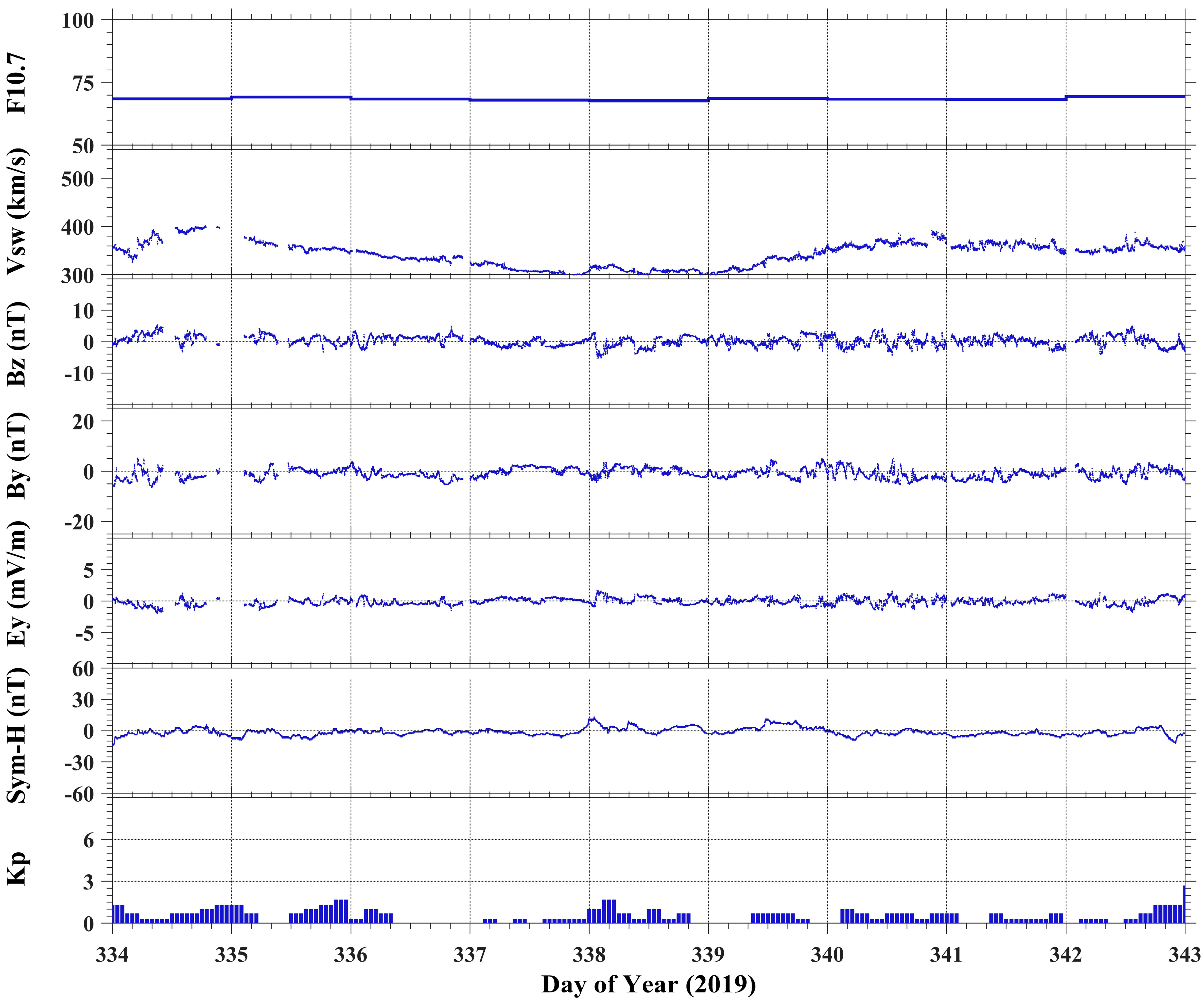
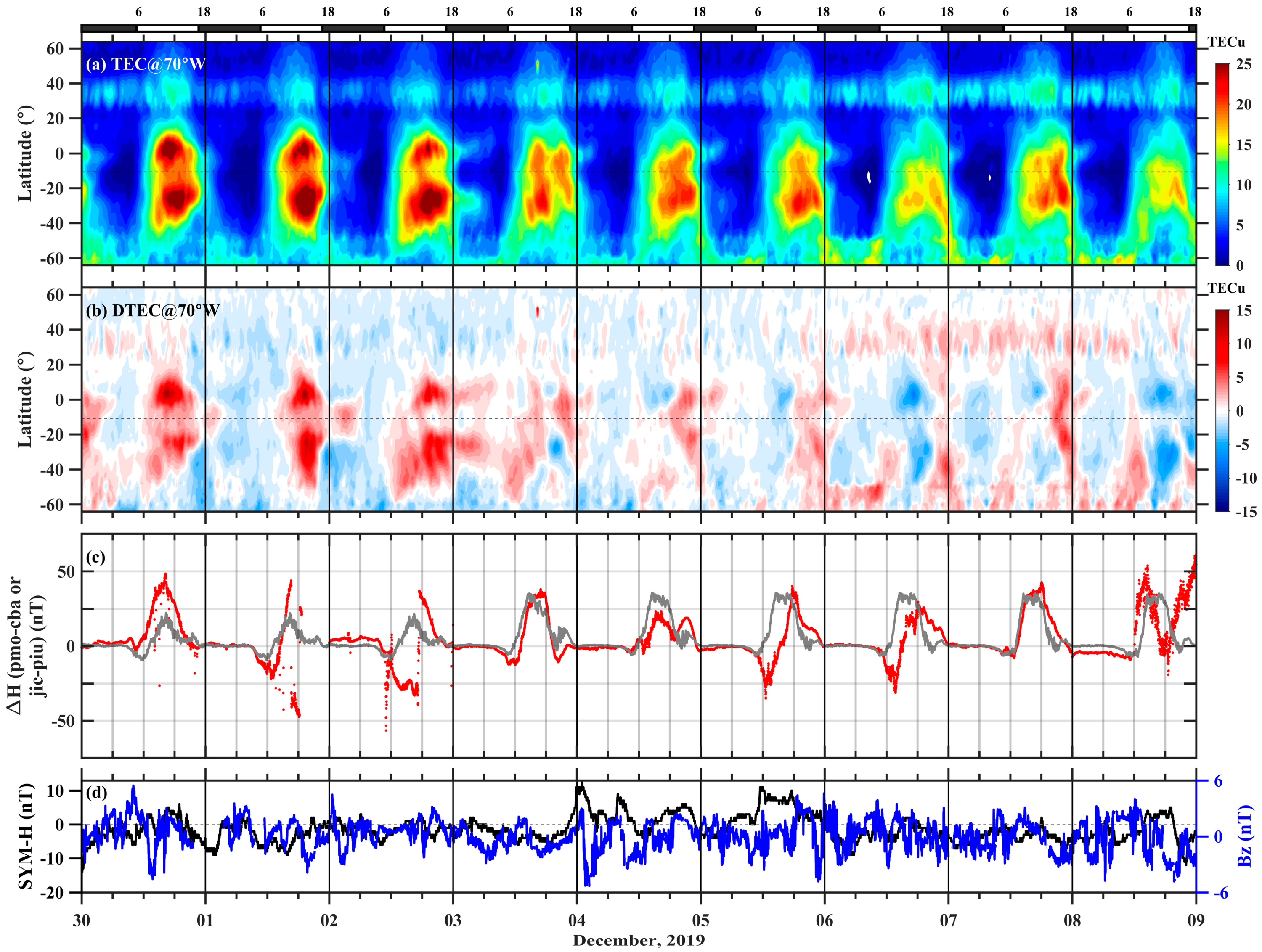


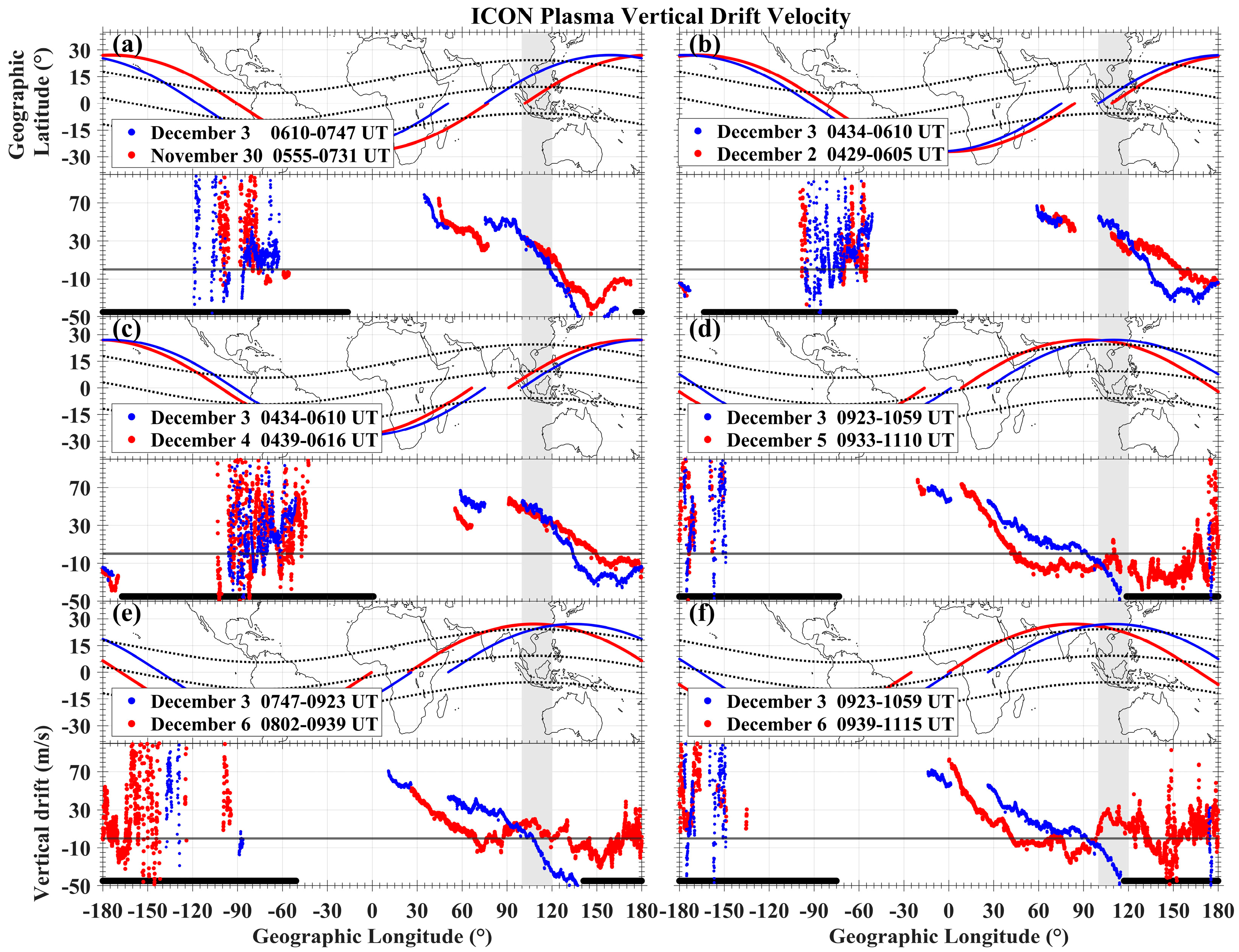
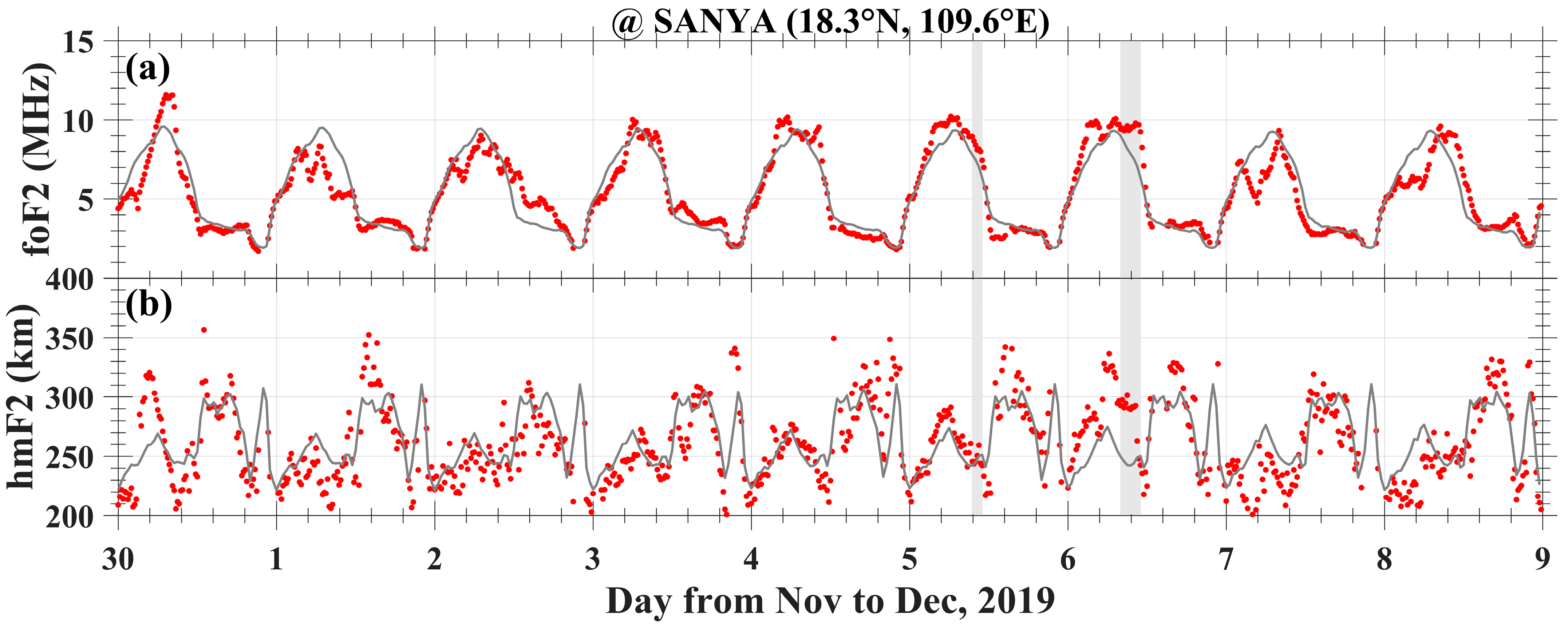

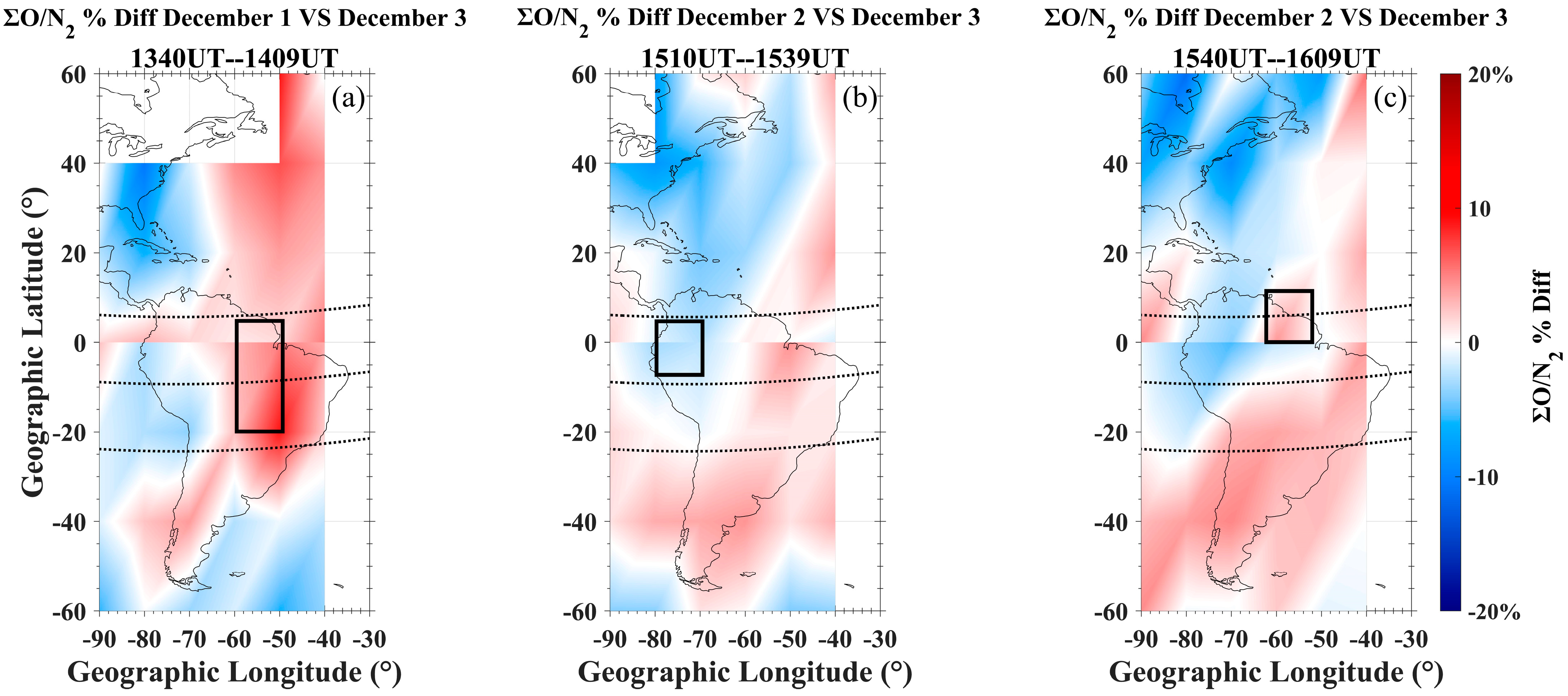
Disclaimer/Publisher’s Note: The statements, opinions and data contained in all publications are solely those of the individual author(s) and contributor(s) and not of MDPI and/or the editor(s). MDPI and/or the editor(s) disclaim responsibility for any injury to people or property resulting from any ideas, methods, instructions or products referred to in the content. |
© 2023 by the authors. Licensee MDPI, Basel, Switzerland. This article is an open access article distributed under the terms and conditions of the Creative Commons Attribution (CC BY) license (https://creativecommons.org/licenses/by/4.0/).
Share and Cite
Sun, H.; Kuai, J.; Zhong, J.; Liu, L.; Zhang, R.; Hu, L.; Li, Q. A New Approach to the Ionosphere at Middle and Low Latitudes under the Geomagnetic Quiet Time of December 2019 by ICON and GOLD Observations. Remote Sens. 2023, 15, 5591. https://doi.org/10.3390/rs15235591
Sun H, Kuai J, Zhong J, Liu L, Zhang R, Hu L, Li Q. A New Approach to the Ionosphere at Middle and Low Latitudes under the Geomagnetic Quiet Time of December 2019 by ICON and GOLD Observations. Remote Sensing. 2023; 15(23):5591. https://doi.org/10.3390/rs15235591
Chicago/Turabian StyleSun, Hao, Jiawei Kuai, Jiahao Zhong, Libo Liu, Ruilong Zhang, Lianhuan Hu, and Qiaoling Li. 2023. "A New Approach to the Ionosphere at Middle and Low Latitudes under the Geomagnetic Quiet Time of December 2019 by ICON and GOLD Observations" Remote Sensing 15, no. 23: 5591. https://doi.org/10.3390/rs15235591







